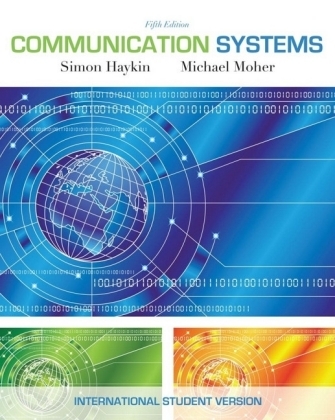
Communication Systems, International Student Version
John Wiley & Sons Inc (Verlag)
978-0-470-16996-4 (ISBN)
This best-selling, easy-to-read, communication systems text continues to include the most comprehensive coverage of digital communications in an undergraduate level text in this fourth edition. In addition to being the most up-to-date communications text available, Simon Haykin has added more MATLAB computer experiments and improved examples and problems throughout. Intended for use in the Communication Systems course in the Electrical Engineering core curriculum. This course is typically offered at the junior/senior level in electrical engineering departments at the majority of four year colleges and universities that have electrical engineering programs. The introductory course in communication systems is required for electrical engineering majors. This text will also appeal to a small segment of the professional engineering market.
Simon Haykin is a University Professor at McMaster University, Hamilton, Ontario, Canada. His research interests include nonlinear dynamics, neural networks and adaptive filters and their applications in radar and communications systems. Dr. Haykin is the editor for a series of books on "Adaptive and Learning Systems for Signal Processing, Communications and Control" published by John Wiley & Sons, Inc. He is both an IEEE Fellow and Fellow of the Royal Society of Canada.
Preface vii
Chapter 1 Prologue 1
1.1 The Communication Process 1
1.2 The Layered Approach 2
1.3 Theme Example—Wireless Communications 3
Notes and References 7
Chapter 2 Fourier Theory and Communication Signals 8
2.1 Introduction 8
2.2 The Fourier Transform 8
2.3 Properties of the Fourier Transform 14
2.4 The Inverse Relationship Between Time and Frequency 28
2.5 Dirac Delta Function 32
2.6 Fourier Transforms of Periodic Signals 39
2.7 Transmission of Signals Through Linear Systems 41
2.8 Filters 47
2.9 Low-Pass and Band-Pass Signals 52
2.10 Band-Pass Systems 57
2.11 Phase and Group Delay 60
2.12 Sources of Information 62
2.13 Numerical Computation of the Fourier Transform 64
2.14 Theme Example—Channel Estimation of a Wireless LAN Channel 66
2.15 Summary and Discussion 69
Notes and References 69
Problems 70
Chapter 3 Amplitude Modulation 74
3.1 Introduction 74
3.2 Amplitude Modulation 75
3.3 Double Sideband–Suppressed Carrier Modulation 83
3.4 Quadrature-Carrier Multiplexing 87
3.5 Single-Sideband and Vestigial-Sideband Methods of Modulation 88
3.6 Theme Example—VSB Transmission of Analog and Digital Television 92
3.7 Frequency Translation 93
3.8 Frequency-Division Multiplexing 94
3.9 Summary and Discussion 95
Notes and References 96
Problems 96
Chapter 4 Phase and Frequency Modulation 102
4.1 Introduction 102
4.2 Basic Definitions 102
4.3 Frequency Modulation 109
4.4 Phase-Locked Loop 127
4.5 Nonlinear Effects in FM Systems 133
4.6 The Superheterodyne Receiver 135
4.7 Theme Example—Analog and Digital FM Cellular Telephones 137
4.8 Summary and Discussion 139
Notes and References 140
Problems 140
Chapter 5 Random Variables and Processes 146
5.1 Introduction 146
5.2 Probability 147
5.3 Random Variables 151
5.4 Statistical Averages 156
5.5 Random Processes 161
5.6 Mean, Correlation, and Covariance Functions 162
5.7 Transmission of a Random Process Through a Linear Filter 168
5.8 Power Spectral Density 169
5.9 Gaussian Process 175
5.10 Noise 179
5.11 Narrowband Noise 186
5.12 Theme Example—Stochastic Model of a Mobile Radio Channel 193
5.13 Summary and Discussion 198
Notes and References 200
Problems 201
Chapter 6 Noise in Analog Modulation 207
6.1 Introduction 207
6.2 Receiver Model 207
6.3 Noise in DSB–SC Receivers 210
6.4 Noise in AM Receivers 212
6.5 Noise in FM Receivers 215
6.6 Pre-emphasis and De-emphasis in FM 226
6.7 Theme Example—Link Budget of FM Satellite Link 229
6.8 Summary and Discussion 233
Notes and References 235
Problems 235
Chapter 7 Digital Representation of Analog Signals 238
7.1 Introduction 238
7.2 Why Digitize Analog Sources? 239
7.3 The Sampling Process 240
7.4 Pulse-Amplitude Modulation 244
7.5 Time-Division Multiplexing 247
7.6 Pulse-Position Modulation 248
7.7 Theme Example—PPM in Impulse Radio 255
7.8 The Quantization Process 256
7.9 Pulse-Code Modulation 260
7.10 Delta Modulation 267
7.11 Theme Example—Digitization of Video and MPEG 271
7.12 Summary and Discussion 273
Notes and References 274
Problems 275
Chapter 8 Baseband Transmission Of Digital Signals 279
8.1 Introduction 279
8.2 Baseband Pulses and Matched Filter Detection 280
8.3 Probability of Error Due to Noise 285
8.4 Intersymbol Interference 290
8.5 Eye Pattern 294
8.6 Nyquist’s Criterion for Distortionless Transmission 296
8.7 Baseband M-ary PAM Transmission 301
8.8 Tapped-Delay-Line Equalization 302
8.9 Theme Example—100BASE-TX— Transmission of 100 Mbps Over Twisted Pair 305
8.10 Summary and Discussion 308
Notes and References 309
Problems 309
Chapter 9 Band-pass Transmission Of Digital Signals 313
9.1 Introduction 313
9.2 Band-Pass Transmission Model 314
9.3 Transmission of Binary PSK and FSK 316
9.4 M-ary Data Transmission Systems 327
9.5 Comparison of Noise Performances of Various PSK and FSK Systems 331
9.6 Theme Example—Orthogonal Frequency Division Multiplexing (OFDM) 333
9.7 Summary and Discussion 337
Notes and References 338
Problems 338
Chapter 10 Information and Forward Error Correction 342
10.1 Introduction 342
10.2 Uncertainty, Information, and Entropy 343
10.3 Source-Coding Theorem 347
10.4 Lossless Data Compression 348
10.5 Theme Example—The Lempel– Ziv Algorithm and File Compression 353
10.6 Discrete Memoryless Channels 355
10.7 Channel Capacity 357
10.8 Channel Coding Theorem 360
10.9 Capacity of a Gaussian Channel 363
10.10 Error Control Coding 366
10.11 Linear Block Codes 369
10.12 Convolutional Codes 379
10.13 Trellis-Coded Modulation 384
10.14 Turbo Codes 388
10.15 Summary and Discussion 393
Notes and References 394
Problems 395
Appendix Mathematical Tables 398
Glossary 405
Bibliography 409
Index 413
| Erscheint lt. Verlag | 1.6.2009 |
|---|---|
| Zusatzinfo | Drawings: 0 B&W, 0 Color |
| Verlagsort | New York |
| Sprache | englisch |
| Maße | 212 x 259 mm |
| Gewicht | 798 g |
| Themenwelt | Technik ► Elektrotechnik / Energietechnik |
| Technik ► Nachrichtentechnik | |
| ISBN-10 | 0-470-16996-6 / 0470169966 |
| ISBN-13 | 978-0-470-16996-4 / 9780470169964 |
| Zustand | Neuware |
| Haben Sie eine Frage zum Produkt? |
aus dem Bereich


